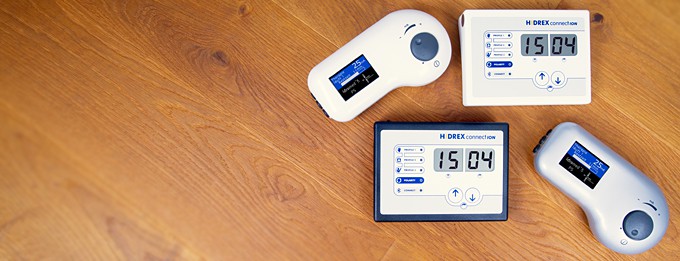Sweat/Restraining the sweat glands
Sweat and sweating certainly fulfil important functions.
When there is excessive sweating without reason
How do our sweat glands work anyway? Or, to put it differently: Can sweat be restrained or suppressed so that it doesn't suddenly affect another body part, which might be even more unpleasant?
Sweat is a natural function of the body to regulate body temperature and dissipate excess heat.
However, sweat can also be a reaction of the body to certain environmental influences, primarily including stress, or rather distress - which is stress originating from different sources.
However, excessive sweating, also known as hyperhidrosis, can become a cosmetic problem for some people, affecting their self-confidence.
Hyperhidrosis can occur in various parts of the body, such as the armpits, hands, feet, face, or other areas.
Is there a perfect solution for excessive sweat and overactive sweat glands?
How to convince the sweat glands to secrete less sweat without damaging them?
The answer may be iontophoresis.
People who suffer from hyperhidrosis often feel uncomfortable and embarrassed, especially in social situations. This can develop into social phobia.
Sweat gland suction
One way to treat the sweat glands in the armpits is to surgically remove them.
For sweaty feet, sweaty hands, and all other areas except for the armpits, sweat gland suction is not suitable.
This procedure, also known as or subcutaneous sweat gland ablation, is typically performed under local anesthesia.
During the procedure, the sweat glands in the affected region are removed to reduce the amount of sweat produced.
Sweat gland removal is a relatively safe and effective treatment method for hyperhidrosis. Most patients experience a significant reduction in sweating after the surgery.
However, it should be noted that sweat glands may regrow or the connections between sweat ducts and sweat glands may regenerate.
Whether one would undergo such a procedure a second time? The suffering would need to be immense.
There are also some risks associated with sweat gland removal, such as infections, bruising, pain, or uneven results.
Before deciding on sweat gland removal, it is important to thoroughly inform yourself about the risks and benefits. It is crucial to choose an experienced and qualified surgeon who can perform the procedure. Most patients do not require a longer recovery time and can resume their normal activities within a few days.
Overall, sweat gland removal can be an effective solution for people who suffer from excessive sweating and do not find relief from other treatment methods. If you are interested in this operation, please consult a qualified surgeon to determine if it is suitable for you.

Sweat glands
What does a sweat gland look like and how is it structured?
1. Sweat emerges from a hair canal.
2. Sweat emerges from a pore.
3. Sweat duct connected with 4.
4. Sweat gland.
Sweat - influencing the sweat glands
Sweat glands play an important role in regulating the body temperature by producing and secreting sweat.
So far, so good.
However, hyperactive sweat glands can lead to problems not only when they produce too much sweat.
Even when they produce too little sweat, you will feel some uncomfortable effects. Insufficient sweat means dry or even cracking skin.
Hyperhidrosis is a condition in which the sweat glands produce excessive amounts of sweat, which can lead to unpleasant physical symptoms and social difficulties.
There are various treatment options for hyperhidrosis, including topical medications, oral medications, botulinum toxin injections, and sweat gland ablation.
Conversely, sweat glands can also be underactive and produce too little sweat, which can cause other health problems such as overheating or dehydration.
Some diseases like diabetes, Parkinson's disease, or hypothyroidism can also cause decreased sweat production.
Especially in the case of diabetic foot, the affected individual usually doesn't have problems like sweaty feet or body odor because too little sweat is produced.
There are natural ways to influence sweat gland activity. For example, certain herbs and foods like sage, cinnamon, and ginger can help regulate sweat production.
Also, using breathable clothing, avoiding spicy foods and alcohol, as well as stress reduction techniques such as yoga and meditation, can help reduce sweat and unpleasant body odor.
However, it is important to consult a doctor if there are changes in sweat production without a reason, whether too much or too little, in order to rule out an underlying condition and discuss appropriate treatment options.
Treatment options to influence sweat glands:
- Sweat gland suction
- Sweat gland ablation
- Microwaves to "cook" sweat glands
- Operations on the sympathetic nerve to exclude entire areas from sweating
- Iontophoresis: A low electric current is used to stimulate normal sweat production in the sweat glands



Where can sweating occur?
Sweat glands are present throughout the body, but they are especially concentrated in certain body parts. A few small areas of the body are occupied by a high concentration of sweat glands. These areas cause a lot of problems when excessive sweat is secreted.
These problematic areas - trouble spots - include:
Hyperhidrosis or overreactivity of the sweat glands ⇔ Sweat as a result of distress
The body is constantly under tension. This is negative stress - called distress.
With simple stress, humans can cope. When stress factors accumulate and occur simultaneously, they stack up to become a package of problems that cannot be easily shrugged off.
The human body responds to stress with increased sweat secretion. Sweat glands become active, for example, to ensure a better grip on a spear and generate more friction through slightly moist skin, allowing for better and longer throws.
If there is too much sweat, one is more likely to slip.
For this reason, under normal stress, humans are usually quite relaxed and only start to sweat slightly.
When stress factors accumulate and build up, each new problem causes a little more sweat than before.
It's no wonder that excessive sweating eventually becomes uncomfortable, and one feels unwell.
Distress refers to negative emotions or a feeling of suffering and discomfort caused by various circumstances.
It can be a reaction to a difficult situation, such as an illness, relationship crisis, job loss, or financial difficulties. Distress can also be a response to traumatic events such as accidents, natural disasters, or acts of violence.
Distress can lead to various physical and psychological symptoms, such as sweating, anxiety, depression, sleep disturbances, headaches, noise sensitivity, muscle tension, high blood pressure, and digestive problems.
If distress persists or worsens, it can lead to serious health problems and impair daily life.
When you consider the range of symptoms, it's no wonder that they can exacerbate the clinical picture of hyperhidrosis.
Getting out of the sweating/distress trap
There are various methods to cope with distress, such as relaxation exercises, meditation, cognitive-behavioral therapy, physical activity, social support, and medication.
The support of friends, family, or professional helpers can be important in finding appropriate coping strategies.
Not all forms of stress or discomfort automatically indicate distress.
There are also positive forms of stress, known as eustress, which can motivate us and enhance our performance.
However, it is important to know the limits of one's own stress and find appropriate coping strategies to avoid distress.
The goal is, of course, a sweat-free future and a reduction in negative thoughts.
